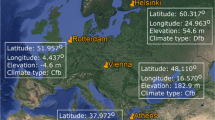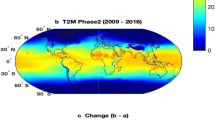Abstract
The present paper describes a physical model that estimates the globe and the natural wet bulb temperatures from the main parameters generally recorded at meteorological weather stations, in order to predict the wet bulb globe temperature (WBGT) heat stress index for outdoor environments. The model is supported by a thermal analysis of the globe and the natural wet bulb temperature sensors. The results of simultaneous measurements of the WBGT and climatological parameters (solar radiation, wind velocity, humidity, etc.) are presented and used to validate the model. The final comparison between calculated and measured values shows a good agreement with the experimental data, with a maximum absolute deviation of 2.8% for the globe temperature and 2.6% for the natural wet bulb temperature and the WBGT index. The model is applied to the design reference year for Coimbra, Portugal, in order to illustrate its preventative capabilities from a practical point of view. The results clearly show that during the summer there is a critical daily period (1200–1600 hours, local standard time) during which people working outdoors should not be allowed to perform their normal activities.





Similar content being viewed by others
References
ASHRAE (1989) Handbook of fundamentals. ASHRAE, Atlanta
ASHRAE (1991) Handbook of applications. ASHRAE, Atlanta
Aubertin M (1976) Le travail en ambience chaude. In: Cahier de notes documentaires, INRS, Paris, 85:509–536
Bird B, Steward W, Lightfoot E (1960) Transfer phenomena. Wiley, New York
Budd M (2008) Wet-bulb globe temperature (WBGT) - its history and its limitations. J Sci Med Sport 11:20–32. doi:10.1016/j.jsams.2007.07.003
Buonanno G, Frattolillo A, Vanoli L (2001) Direct and indirect measurement of WBGT index in transversal flow (2001). Measurement 29:127–135. doi:10.1016/S0263-2241(00)00033-6
Churchill W (1983) In: Schlünder U (ed) Heat exchanger design handbook. Hemisphere, New York
Dernedde E, Gilbert D (1991) Prediction of wet-bulb globe temperature in aluminum smelters. J Am Ind Hyg Assoc 52(3):120–126
EU-OSHA (2005) Expert forecast on emerging physical risks related to occupational safety and health, Risk Observatory. European Agency for Safety and Health at Work (EU-OSHA), Belgium
Gaspar A, Quintela D (1996) Development of a Design Reference Year. Application to the case of Coimbra. In: Fernandes O, Maldonado E and Almeida M (eds) Proceedings of VIII Congresso Ibérico de Energia Solar, Porto, Portugal. In Portuguese
Gebhart B (1971) Heat transfer, 2nd edn. McGraw-Hill, New York
Griefahn B (1997) Acclimation to three different hot climates with equivalent wet bulb globe temperatures. Ergonomics 40(2):223–234. doi:10.1080/001401397188314
ILO (2001) Ambient factors in the workplace, International Labour Organization (ILO) codes of practice. International Labour Office, Geneva
Incropera F, De Witt P (1990) Fundamentals of heat and mass transfer, 3rd edn. Wiley, New York
Iqbal M (1983) An introduction to solar radiation. Academic Press, Canada
ISO 7243 (1989) Hot environments - Estimations of the heat stress on working man, based on the WBGT Index (Wet Bulb Globe Temperature), International Standard, 1st edn. International Organization for Standardization (ISO), Geneva
ISO 7726 (1998) Ergonomics of the thermal environment - Instruments for measuring physical quantities, International Standard, 2nd edn. International Organization for Standardization (ISO), Geneva
Kambezidis D, Psiloglou E, Gueymard C (1994) Measurements of models for total solar irradiance on inclined surfaces in Athens, Greece. Sol Energy 53(2):177–185. doi:10.1016/0038-092X(94)90479-0
Kipp & Zonen (1992) Instruction manual Pyranometer CM 11/14. Part no. 0305–201 (9205), Kipp & Zonen
Kondratyev Y (1969) Radiation in the atmosphere. International Geophysics Series, vol 12. Academic Press, New York
McIntyre D (1980) Indoor climate. Applied Science, London
Mitchell J (1976) Heat transfer from spheres and other animal forms. Biophys J 10:561–569
Monteith L (1973) Principles of environmental physics. Edward Arnold, London
Moran S, Shitzer A, Pandolf B (1998) A physiological strain index (PSI) to evaluate heat stress. Am J Physiol 274(44):R129–R134
Moran S, Pandolf B, Shapiro Y, Heled Y, Shani Y, Mathew T, Gonzalez R (2001) An environmental stress index (ESI) as substitute for the wet bulb globe temperature (WBGT). J Therm Biol 26:427–431. doi:10.1016/S0306-4565(01)00055-9
Moran S, Pandolf B, Shapiro Y, Laor A, Heled Y, Gonzalez R (2003) Evaluation of the environmental stress index for physiological variables. J Therm Biol 28:43–49. doi:10.1016/S0306-4565(02)00035-9
Moran S, Pandolf B, Shapiro Y, Heled Y, Gonzalez R (2004) Evaluation of the environmental stress index (ESI) for different terrestrial elevations below and above sea level. J Therm Biol 29:491–497
Parsons K (2006) Heat Stress Standard ISO 7243 and its global application. Ind Health 44:368–379. doi:10.2486/indhealth.44.368
Paul B, Martin M (1984) Emissivity of clear skies. Sol Energy 32(5):663–664. doi:10.1016/0038-092X(84)90144-0
Santee R, Wallace F (2005) Comparison of weather service heat indices using a thermal model. J Therm Biol 30:65–72. doi:10.1016/j.jtherbio.2004.07.003
Steadman R (1979) The assessment of sultriness. Part I: a temperature-humidity index based on human physiology and clothing science. J Appl Meteorol 18(7):861–873. doi:10.1175/1520-0450(1979)018<0861:TAOSPI>2.0.CO;2
Taylor N (2006) Challenges to temperature regulation when working in hot environments. Ind Health 44:331–344. doi:10.2486/indhealth.44.331
Wenzel H, Mehnert C, Schwarzenau P (1989) Evaluation of tolerance limits for humans under heat stress and the problems involved. Scand J Work Environ Health 15(suppl 1):7–14
WHO (1969). Health factors involved in working under conditions of heat stress. World Health Organisation (WHO), Technical Report Series, no. 412, Geneva
Wylie R, Lalas T (1992). Measurement of temperature and humidity specification, construction, properties and use of the WMO reference phychrometer. Technical note no. 194, WMO, Geneva
Author information
Authors and Affiliations
Corresponding author
Rights and permissions
About this article
Cite this article
Gaspar, A.R., Quintela, D.A. Physical modelling of globe and natural wet bulb temperatures to predict WBGT heat stress index in outdoor environments. Int J Biometeorol 53, 221–230 (2009). https://doi.org/10.1007/s00484-009-0207-6
Received:
Revised:
Accepted:
Published:
Issue Date:
DOI: https://doi.org/10.1007/s00484-009-0207-6




